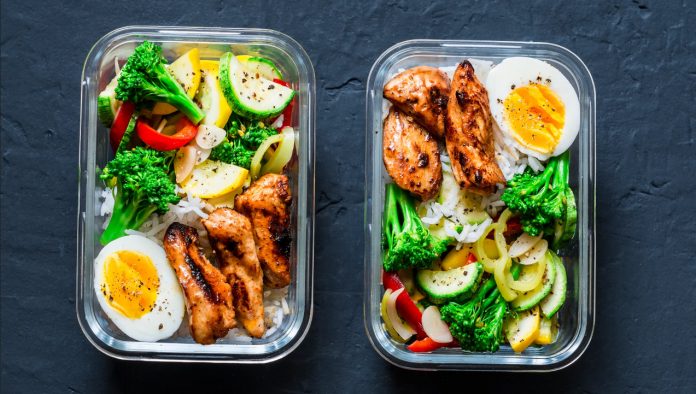When it comes to leftovers, I’m never sure how long I can eat something before I should probably toss it. In some cases, I’ve opened up containers of food that I’ve had for over a week and they’ve looked (and smelled) totally fine, but I couldn’t help feeling a bit uneasy diving in with a fork considering how long they had been sitting there. On the other hand, I’ve also seen food start to stink and smell after only two days in the fridge.
Leftovers make my life easier for so many reasons—from cutting down my work time in the kitchen to minimizing the amount of food waste I create—but I really, *really* don’t want them to get me sick. So I asked food safety experts how to stay on the safer side. It turns out, you can’t just look at leftovers and know if they’re safe to eat or not, because germs growing on food are often invisible to the naked eye (besides mold, of course). But there are a few things you can do to figure out if you can still eat something or are better off tossing it—plus, some ways to store leftovers to maximize their lifespan.
How long leftovers really last
The FDA says you should typically only keep leftovers in the fridge for up to four days (womp womp), but Randy Worobo, Ph.D., professor of food microbiology at Cornell University, tells SELF that they can potentially last for up to a week depending on how they’re handled. (Food stored in the freezer, though, can last indefinitely.)
If you’ve ever eaten questionably old leftovers and been totally fine, then you should consider yourself lucky. Whether or not you got sick after eating very old food has nothing to do with your “iron stomach” and everything to do with whether or not that food contained bacteria that could cause a foodborne illness, Worobo says. As for the types of pathogens that might be on your food, he says that salmonella, E.coli, and listeria are the most common. If you did eat super old leftovers and didn’t get sick, it’s likely there either weren’t any pathogens on your food, or the amount was simply too small to get you sick. Worobo explains that the amount of microorganisms that will get you sick varies dramatically—for example, norovirus requires one to 10 microorganisms whereas it can take over 100,000 to get infected with salmonella.
So how can you know if your week-old pizza has dangerous bacteria on it or not? You can’t, because the pathogens that might get you sick aren’t visible to the naked eye, Worobo says. Old food could be dangerous to eat even if it looks totally fine, which is why it’s better to use time as a frame of reference if you don’t want to take the risk, he says. And, of course, if something *does* have visible mold on it, it’s best to throw it out. (Just because something has spoiled or has mold on it doesn’t necessarily mean it’s going to give you a foodborne illness, Worobo says, but it’s better to be safe than sorry in this case.)
I’m going to be totally honest and possibly jinx myself here: I’ve eaten leftovers that I’ve had for longer than a week many, *many* times, and I’ve never gotten sick, so I asked Worobo why that might be. He says that the risk of getting sick from leftovers is actually pretty small, provided you use proper food handling practices (more on that in a bit). If there are no dangerous pathogens on your food, there never will be, unless they are introduced at some point.
“There’s no immaculate conception of bacteria,” he jokes. So as long as you make sure to avoid any cross-contamination and handle food properly so that any existing pathogens can’t multiply to dangerous amounts, he says that leftovers can last up to a week in some cases. After that point, though, it’s no longer worth the risk, especially for very young children, elderly adults, people with autoimmune conditions, pregnant women, people with conditions like diabetes and HIV/AIDS, and those undergoing treatment for cancer, he says, because they’re more likely to get sick from a much smaller amount of bacteria.
One exception to this rule is seafood, says Philip Tierno, Ph.D., clinical professor in the departments of microbiology and pathology at NYU Langone Medical Center. “Generally speaking, the most contaminated food product is seafood and it breaks down easily and quickly,” he explains. “Fish with an odor is being broken down and bacteria are increasing in population.” Anyone who’s eaten seafood knows how quickly it can go from smelling delicious to smelling sour, and the FDA doesn’t recommend holding onto any fresh seafood leftovers for more than one to two days (smoked fish, on the other hand, will be fine for up to 14 if packaged in an airtight container).
If you’re wondering why it seems like cooked leftovers don’t last as long in your fridge as the raw ingredients do, it’s because they don’t, says Worobo. Bacteria develops more quickly in cooked food for a handful of reasons. “Microorganisms need water, the proper temperature, and the proper acidity [to multiply],” he explains, “so if you take a cake mix and add water and eggs, you’re supplying the nutrients for the pathogens.”



























